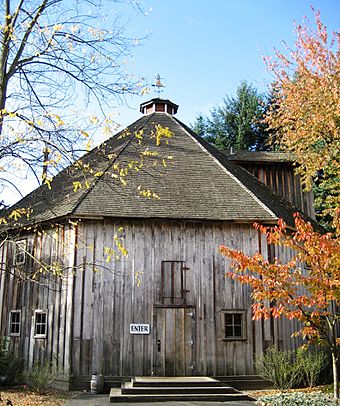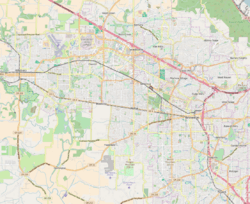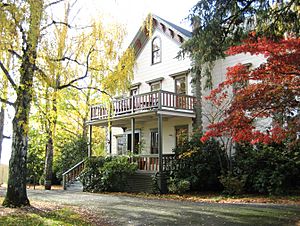Imbrie Farm facts for kids
Quick facts for kids |
|
|
Imbrie Farm
|
|

Eight-sided Barn at Imbrie Farm
|
|
| Location | 4045 NW Cornelius Pass Road, Hillsboro, Oregon 97124 |
|---|---|
| Area | 3 acres (1.2 ha) |
| Built | 1855 |
| Architect | Frank Imbrie |
| Architectural style | Italian Villa |
| NRHP reference No. | 77001117 |
| Added to NRHP | February 15, 1977 |
The Imbrie Farm is a historic home in Hillsboro, Oregon. It was built in the style of an Italian Villa. Robert Imbrie built this house, and the property was a busy farm for over 100 years. In 1977, it was added to the National Register of Historic Places, which lists important historical sites.
Today, the old farm is located near U.S. Route 26 on Cornelius Pass Road. It is now home to a restaurant and gathering place called the Cornelius Pass Roadhouse, run by a company called McMenamins. The original buildings on the farm include the main house, a special eight-sided barn, and a shed.
What is Imbrie Farm Like Today?
The old Imbrie Farm is now a popular spot operated by McMenamins, a company from Portland, Oregon. The property has beautiful old trees, like English chestnut and black walnut trees. Some of these trees are more than 130 years old!
McMenamins has turned the farm into a fun place for people to visit. It includes a brewery (where they make drinks), a distillery (where they make spirits), and large outdoor areas. You can also see the historic eight-sided barn and the main house, which is called Imbrie Hall. The main house, built in 1866, is decorated with original art and old-fashioned furniture. It's often used for special events and parties.
History of the Imbrie Farm
The Imbrie family first arrived in Oregon in the mid-1840s. They were among the first white settlers to come to the area. The Imbries came from the Midwest, but the family's leader, James Imbrie, Jr., was born in Scotland.
James's sons, James III and Robert, each started their own farms in Washington County. James III had a farm in North Plains. His brother Robert took over and expanded a nearby farm, which is where the current buildings are located. Robert traveled to Oregon by ship, sailing all the way around Cape Horn.
Robert built a granary (a building for storing grain) in the mid-1850s. About ten years later, in 1866, he started building the large, three-story Italian Villa-style home. It took three years to finish the house, which they named "The Gables." At this time, Robert and his wife had 12 children, and Robert's mother also lived with them. The family raised strong horses called Morgans to sell to other farmers.
Later, Robert's son Frank took over the farm. He changed it into a dairy farm and added the unique eight-sided barn around 1900. Future generations of the family lived in the home. They added modern features like electricity and indoor plumbing in the 1930s. Frank's son, James Hay, changed the farm's focus to growing grain and hay. They even grew barley that was used to make Blitz-Weinhard beer in the mid-1900s.
By the 1970s, the family stopped farming. In 1977, Gary Imbrie, a great-great-grandson of James Jr., opened the Imbrie Farmstead Restaurant in the old house. In 1984, Donald and Billie Jean Herman bought the property and continued running the restaurant. They later leased the operations to McMenamins.
In 1986, McMenamins took over the property. They eventually bought and restored the buildings. They turned the farm into the Cornelius Pass Roadhouse, which is a popular brewpub today.
Important Dates for Imbrie Farm
- 1843: Edward Henry Lenox, who was 18, traveled the Oregon Trail. He claimed the land where the farm is now.
- 1850-1859: Robert Imbrie bought the Lenox farm. He built the granary that is still there.
- 1863-1866: Robert had the three-story farm home built.
- 1897: Robert Imbrie passed away.
- 1933: The Imbrie family started selling barley to Blitz-Weinhard.
- 1945: Frank Imbrie passed away.
- 1962: James Hay Imbrie closed down the family's farm after 100 years.
- 1968: James Hay Imbrie passed away.
- 1969: James Hay's son, Frank, moved his family to the old homestead. They were the sixth and last generation of Imbries to live there.



